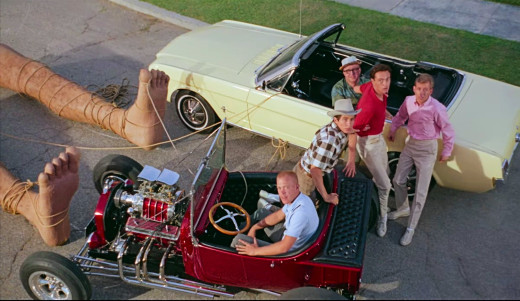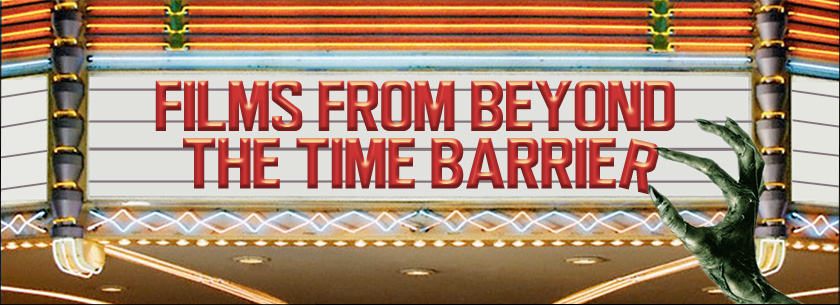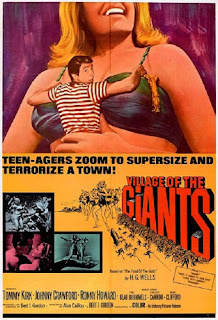Pros: Interesting cast made up of former child stars, future stars and sons and daughters of acting royalty; Striking images; Catchy music
Cons: Variable special effects and abrupt changes in mood and tone make for a head-scratching experience
Movie blogger Rebecca Deniston at Taking Up Room has done it again with her Fake Teenager Festivus, an opportunity for the blogging community to celebrate all those egregious instances of 20-something-plus actors portraying teenagers in movies and TV.
As she points out in her call for submissions, employing older actors as teenagers has long been a filmmaking tradition for a number of reasons, not the least of which are those pesky child labor laws that limit the number of hours a real teenager can work. And then there’s the need to hire a tutor for the little darlin’s schooling if the production is a particularly long one and commuting is impractical. What a bummer!
Another consideration is the actor’s competence. Like any complex skill, acting requires patience, perseverance, and time to perfect. In many cases, it takes a more mature professional to credibly portray an angst-ridden teenager.
But it’s something of a tight-rope act. Go too far, and you risk turning your “teenager” into an unintentional parody. I was curious about how far filmmakers have pushed the envelope, so I googled “Older actors who have played teenagers in movies.”
Since it’s such a fun topic there are plenty of lists out there, but the most comprehensive one I found was on IMDb with 186 (count ‘em!) entries. According to the list, the all-time age disparity record-holder is O.Z. Whitehead, who was 51 (?!) when he played a school boy in The Man Who Shot Liberty Valance. Other notorious cases are there, like 30-year-old Olivia Newton-John playing 17-year-old Sandy in Grease.
 |
| O.Z. Whitehead, the oldest movie teenager ever! (Seen here in The Grapes of Wrath, 1940) |
While mid-to-late 20s is pretty old to be playing a teen, there are 33 actors and actresses on the list who were 30 or older when they were asked to channel their inner teenager. Yikes!
There are no 30+ actors pretending to be teenagers in Village of the Giants, but it does boast several 20-somethings. I chose Village for several reasons:
- My specialty on this blog is looking at plucky low- or no-budget genre movies that strive to overcome their limitations (or at least thumb their noses at them);
- It features an intriguing cast, including two childhood heroes of mine, Disney child star Tommy Kirk and Johnny Crawford of The Rifleman fame; Beau Bridges, son of Lloyd and brother of Jeff; and Ron Howard, who at the time was still making cute as Opie on The Andy Griffith Show;
- Village was written and directed by Mr. B.I.G. himself, Bert I. Gordon, who famously made do with limited budgets and modest special effects in his obsessive quest to make pictures about REALLY BIG people and animals.
In the spirit of the original Festivus, I plan to air my grievances against this movie (but not in an overly derogatory manner, as this would violate the rules), and demonstrate feats of mental strength in analyzing plot and character development (dinner and the Festivus pole are not included). If you decide to perform your own feat of mental toughness by sticking with this post to the bitter end, just be aware that there will be a quiz.
Where to begin? First of all, Village of the Giants is a cinematic examination of the tendency of even freedom-loving societies to succumb to authoritarianism in the face of extreme power differentials and high levels of inequality. It also highlights the difficulty in a high-tech society of ensuring that inventors are suitably rewarded while at the same time the benefits of new technologies are fairly distributed. Lastly, it examines the age-old generation gap, and the balancing act that a healthy society must perform between encouraging the enthusiasm of youth and respecting the wisdom of maturity. But more on that later.
Before I get into the airing of grievances, I will try to sum up the plot as succinctly as I know how to.* On the outskirts of Hainesville, Anywhere, USA, a group of spaced-out juvenile delinquents** run their car into a mudslide, and after celebrating the occasion by dancing sensuously in the mud, they hike into the nearby town.
Meanwhile, the town’s child prodigy, “Genius” (Ron Howard) accidentally creates a compound in his basement lab that can grow animals to enormous size, which he not-so-creatively dubs “Goo.” When Genius’ big sister Nancy (Charla Doherty) and her boyfriend Mike (Tommy Kirk) watch a cat and then two ducks accidentally eat the Goo and grow into giants, they immediately recognize the money-making potential, not to mention the implications for the world’s food supply.
 |
| Opie, er, um Genius patiently explains the amazing properties of Goo. |
A little while later, anybody who’s anybody under the age of 20 (wink, wink) has converged on the local dance club to rock out, including Mike and Nancy, Mike’s friend Horsey (Johnny Crawford), and the delinquent gang led by Fred (Beau Bridges).
Everyone is freaked out when the two giant ducks crash the party and “dance” alongside the kids. Mike dopily spills the beans that the ducks are his, and hints to another delinquent (Harry, played by Kevin O'Neal) that they’re the result of a “million dollar” secret food additive. Harry reports back to Fred, who tasks his girlfriend Jean (Tisha Stirling) with pumping Mike for information, while he tries his charms on Nancy.
The delinquents fail to pry any more information out of Mike or Nancy, but later that night, they sneak over to Nancy’s house and one of the gang (Pete, played by Tim Rooney) breaks into the basement lab. He manages to grab the Goo, but not before setting off a burglar alarm of Genius’ that, among other things, shoots fireworks into the sky.
Mike, Nancy, Horsey and other assorted good kids race over to Nancy’s to confront the delinquents, but in the ensuing altercation Fred and the gang make off with the Goo. The gang retreats to their makeshift hideout in an abandoned downtown theater, where they argue over what to do with the stuff. Peer pressure being what it is, they all succumb to curiosity and eat the Goo, turning into 30-foot-tall giants. (The girls, demonstrating that even delinquents have limits, modestly cover themselves as they quickly outgrow their clothes.)
They fashion toga-like costumes for themselves out of theater curtains, and decide to make a huge impression at yet another teen party at the local park. One of the giant girls grabs Horsey, and he holds on for dear life to her makeshift top straps as she dances around. When Mike objects, Fred sends him crashing into the bushes with one sweep of his hand.
Soon, the sheriff (Joe Turkel) and his deputy show up and demand that the overgrown teens vacate the park. (Somehow, none of the partygoers or the sheriff seem particularly alarmed at the presence of a group of giant delinquents, as if they were more a nuisance than a threat to life and limb.)
 |
| The giant teens look down on the puny citizens of Hainesville with disdain. |
The next day the sheriff confronts the overgrown youths at their theater lair and tells them to get out of Dodge (er, Hainesville). But they’ve got an ace up their giant toga sleeves: they’ve kidnapped the sheriff’s young daughter and are holding her hostage. Fred announces that it’s a new regime -- adults are out and giant teens are in.
He issues a list of demands, including a 9 pm curfew for adults, public speech must be pre-approved by the group, a work party of adults is to be formed to bring the group food, all communication with the outside world must be suspended, and all guns and ammo are to be rounded up and delivered to the theater. Uh-oh. As they say, power tends to corrupt, and being a giant corrupts absolutely.
Will Mike, Nancy and friends rescue the sheriff’s daughter and overthrow Fred’s tyrannical regime? Will Genius come up with an antidote to the Goo to save humanity from the threat of petulant 30-foot somethings with hormonal attitudes? These are monumental questions.
And now for the airing of grievances…
Extraneous dance numbers. At the risk of sounding like one of the dour town elders from Footloose, there is a lot of dancing in Village of the Giants. I mean… a … lot … The bad teens dance in slow motion in the semi-psychedelic titles sequence, then there’s the sensual mud dancing, then there’s the big party at the dance club with everyone, including the two giant ducks, shimmying to the tunes of the Beau Brummels ***, then there’s a close-up of a go-go dancer (Toni Basil as “Red”), then there’s a reprise of the giants dancing in slo-mo in the park, and then there’s Red dancing in front of Fred and the boys to distract them while some of the good kids try to rescue the sheriff’s daughter… whew! I get it that this is a youth picture, but most of these scenes could have been cut down to size.
On the upside: The slow-motion dancing with the kids decked out in make-shift togas is almost hypnotic, the theme-music has a nice beat, and the Beau Brummels dance club song isn’t bad either.
 |
| There is sooo much dancing! So very, very much... |
Shifting tone and mood. IMDb lists Village as first and foremost a comedy, but this is not your ‘60s era light fantasy-comedy like The Shaggy Dog or The Absent Minded Professor. Village’s tone veers wildly from light (e.g., cute little Ronnie Howard patiently explaining his experiments using polysyllabic chemical compound names) to dark (kidnapping the sheriff’s daughter with an implied threat of violence) to light again, causing whiplash of the brain. The worst instance is showing the giant ducks happily dancing and flapping their wings at the dance club (cute!), and then in the next scene displaying their giant plucked carcasses on a barbecue spit as the teens gather round to munch on them. Oh the humanity!
 |
| Little do they know that they will soon be guests of honor at a community barbecue. |
Variable special effects. As mentioned above, filmmaker Bert I. Gordon’s reach for all things BIG in his movies often exceeded his grasp. Gordon reached for the sky in Village, featuring, in addition to the giant teenagers, a giant cat, dog, two ducks and a big-ass spider. In his autobiography, Gordon described a number of techniques he used on Village, including traveling mattes, rear projection, and wide angle shots from a low angle to force the perspective. [Bert I. Gordon, The Amazing Colossal Worlds of Mr. B.I.G.: An Autobiographical Journey, 2009, pp. 72-85]
Unmentioned is the film’s cheesiest and most laughable effect: A pair of 10 foot tall legs, complete with simulated hair, constructed for a scene in which some of the town’s teenagers, riding around on motorcycles and in hotrods, try to lasso and trip up Fred as he steps outside. The legs, which look like they’re made out of paper mache, don’t move at all during the way-too-long scene, making them unintentionally comical (at least I think it’s unintentional).
Another pseudo-effect is filming the giant teens in sloowwww-moootion, emphasizing their ponderous size, while intercutting with shots of the town’s normal-sized citizens scurrying around at normal speed. This makes the normies look like Keystone Kops tripping over each other. It's funny in an odd sort of way.
On the upside: The shots of a panicked Johnny Crawford dangling from the giant girl as she swirls around are memorable (if you're into that sort of thing). Mr. B.I.G. apparently liked this effect a lot, as it’s prominently featured on the original poster.
 |
| Fred's giant legs are down for the count after the Hainesville Hot Rod Rodeo. |
And now for the Festivus feat of mental strength and acuity…
It’s your turn! From the cast list, can you guess who was an actual teenager at the time and who was not?
- Mike - Tommy Kirk
- Nancy - Charla Doherty
- Horsey - Johnny Crawford
- Fred - Beau Bridges
- Rick - Robert Random
- Merrie - Joy Harmon
- Jean - Tisha Sterling (daughter of Ann Sothern)
- Pete - Tim Rooney (son of Mickey Rooney)
I dare you to witness the far-out grooviness on display here:
Where to find it: The MST3K version is available on multiple streaming platforms; For a rad Blu-ray copy, try here.
_________________
* In other words, not very succinct.
**Juvenile delinquency is not so much a thing anymore, since today’s pressure to cultivate and protect one’s social media image means that a teenager (or pre-teen for that matter) can scarcely put down his/her smart phone long enough to get into trouble.
***The Beau Brummels was a San Francisco rock band formed in 1964. When Village was released in 1965 they were red hot, with smash hit singles Laugh, Laugh and Just a Little debuting that year.

















